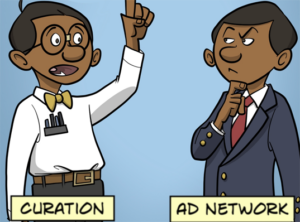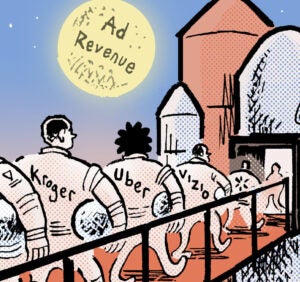 “Data-Driven Thinking” is written by members of the media community and contains fresh ideas on the digital revolution in media.
“Data-Driven Thinking” is written by members of the media community and contains fresh ideas on the digital revolution in media.
Today’s column is written by Rachael Hadaway, vice president of media solutions at 84.51°.
The speed at which data and technology has been deployed to enable advertising functions over the last five years is astonishing. A once complex ecosystem has become even more fragmented by the advent of a whole new ad tech industry.
And while it is undeniable that these advancements have made us faster and cheaper, the jury is still out on whether or not we are always better. The driver of our collective insecurity over our success is not that technology is flawed, but whether we are anchoring to the wrong problem. We are relying on technology to make our work easier to accomplish vs. making people’s lives easier.
Making people’s lives easier isn’t an abstract aspiration; it is as simple and straightforward as it has always been. When inspiration, relevancy and strong value come together, decisions to buy become seemingly effortless.
Death By A Thousand Cuts
Our haste in finding and serving ads to people anywhere and everywhere has fostered forgetfulness in what constitutes a meaningful message. Prior to the digital era, when fewer advertising channels existed, developing strong, memorable messages won or lost the day. The best campaigns connected with consumers on an emotional level and had the ability to impact brand equity for years after they ended.
In this day and age marketers are placing less importance on the gravitas of the message and more on the number of points of distribution. We have convinced ourselves that this approach is about creating a 360-degree media experience. But in many cases, this is simply something we tell ourselves to justify our fear of missing even one touch point.
Because We Can Doesn’t Mean We Should
In the course of our daily lives, we leave trackable footprints everywhere. People and computers analyze these behavioral markers of where we’ve been and what we’ve done, which are collected in massive data sets used to create maps of what we will likely want and need.
For marketers, this insight has become invaluable ammunition for blasting out brand-centric communications. This type of targeting has the potential to be extremely effective. Highly targeted, relevant advertisements can deliver a return that is 10 times greater than untargeted communications.
Unfortunately, many go astray in two important ways. First, marketers use all of the data and insights to target the right people in the wrong way. Marketers use this information to conquest competitive brands and categories. Second, marketers assume that any abandonment of an online purchase was somehow in error and should immediately be corrected by retargeting and following someone across the web.
Value Has Left The Building
In the last two years, an estimated $500 billion in venture capital has been invested in ad networks, data providers and exchanges. But marketing budgets have not kept pace with the number of constituents in the ecosystem that need to get paid.
To keep up the pace, marketers have routinely short-changed the very people they are trying to engage: their consumer. For most people, a strong and believable value proposition is the primary reason they choose to make or not make a purchase. Missing this key component is like fumbling a football on the 5-yard line.
Advertising Technology Is Not The Problem Or A Strategy
These rapid and significant advancements in capability provide marketers valuable tools and insight. They tell us what works and where focus is needed, and enable us to execute and optimize a marketing plan.
In order to anchor to the problem of making people’s lives easier, marketers should remember that what worked before still works today. The best-performing campaigns will directly address the needs of the individual. This means creating a balance of inspiration and relevancy while delivering a strong value proposition and a clear call to action.
Marketers should also keep in mind that consumer expectation of the value placed on their time is growing every day. Channel proliferation means people are no longer a captive audience. Most are becoming savvy enough to pick and choose how they will consume information. Advertisers that respect and enhance this need are best positioned to win.
Finally, marketers should pass on unnecessary ad tech. While it is tempting to invest in every new technology, it can come at a high price. Not only is there the budget impact, there is an impact to the share of mind for teams and to the share of voice for consumers. Decide on a strategy and then set out to find technology that helps accomplish goals.
At the end of the day, it’s all about delivering the right message to the right customer at the right time, and using the technology at hand in a sophisticated way.
Follow 84.51° (@8451group) and AdExchanger (@adexchanger) on Twitter.











